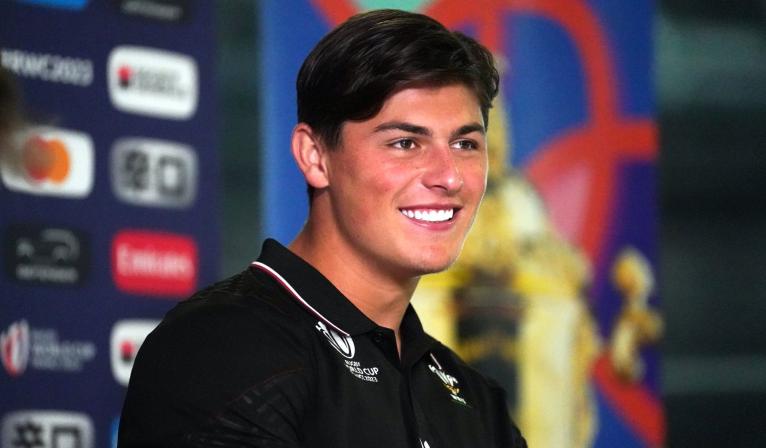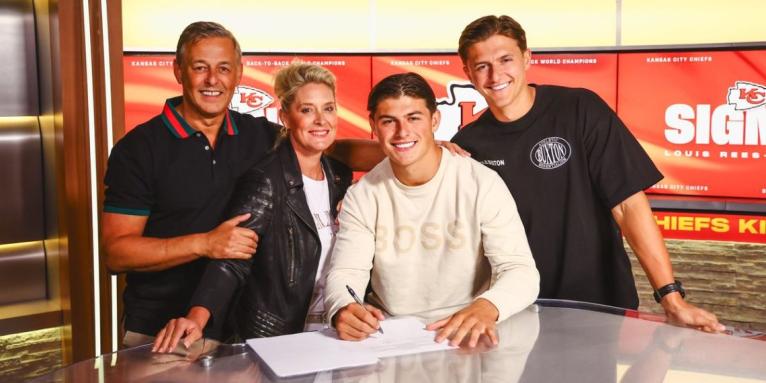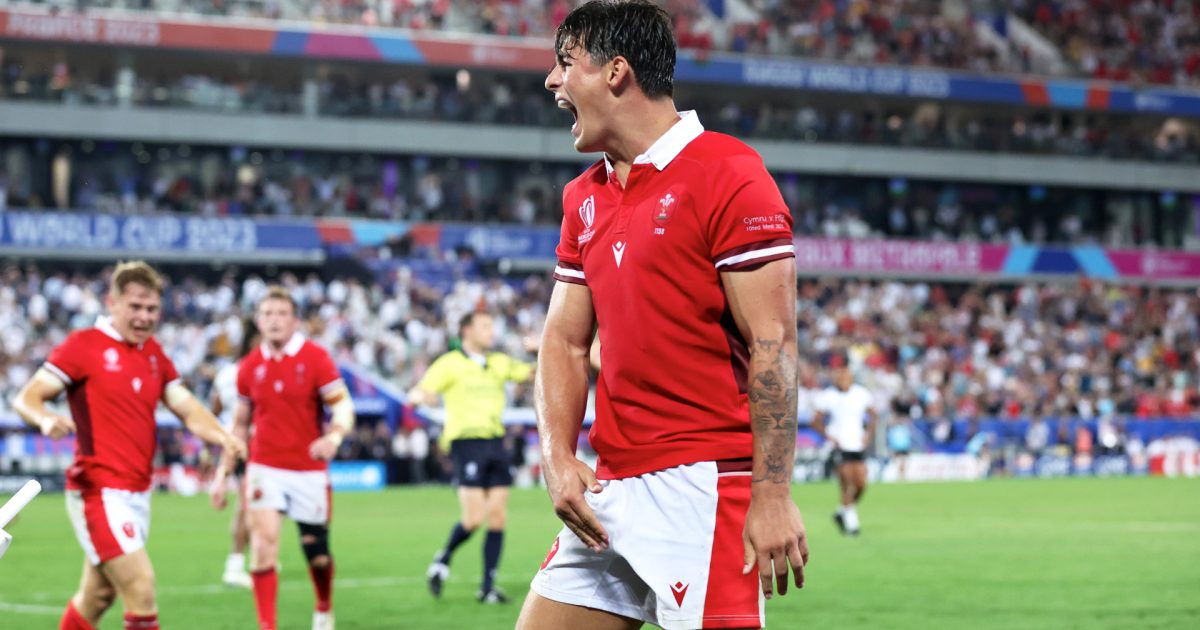Louis Rees-Zammit's NFL switch is a net positive for rugby

If you enter the term ‘rugby values’ into a search engine, a few ubiquitous metrics are cited. On World Rugby’s website ethereal variables such as ‘integrity’, ‘passion’ and ‘discipline’ are listed. The English RFU adds ‘respect’, ‘enjoyment’ and ‘sportsmanship’ to the mix.
All accurate, but this does not paint the full picture. Rugby’s values are also rooted in more primal emotions. Aggression, bravado, arrogance, brute force, smashing the opposition into next week – these are just as integral as the noble virtues espoused by the amateur Victorians who codified the sport and took it around the world.
Which is why the hand-wringing and pearl-clutching over Louis Rees-Zammit’s move to the National Football League has struck a nerve. Oliver Brown in the Daily Telegraph stretched for hyperbole when he wrote that, “American tanks are parked firmly on rugby’s lawn,” while an editor of this site worried that American football “legitimately threatens rugby’s long-term sustainability’.
Of course the anxiety is not merely rooted in insecurity. The Welsh board has stumbled from one mismanaged fiasco to the next in recent years and it’s fair to say that the English game has seen better days. Add to the mix the struggles of the code in Australia and one might rightfully wonder if the sport’s health was in decline.
But this is akin to an otherwise chiselled athlete spending too much time worrying about their underdeveloped calves. If only they would look up in the mirror and see a ripped torso and bulging shoulders and arms then perhaps those insecurities would melt away.
Last year global rugby participation rose by 11 per cent from 2022, reaching 8.46 million players. More than half of all active players in the post-pandemic era are pre-teen. New concussion protocols and improvements in player welfare are better protecting participants. The women’s game is growing at a rapid rate with attendance records shattered every season. And with a 30 per cent increase in the number of clubs worldwide, and with substantial growth in emerging nations such as Singapore, Ghana, NIgeria, Spain and Belgium, rugby administrators and fans have every reason to puff out their chests and consider themselves tethered to a project on the rise. Not convinced? By most accounts the last two World Cups – the men’s in 2023 and the women’s in 2022 – were the best of all time
Insecurity is woven into rugby’s narrative. Mistakes by referees are said to be killing the game. Salary cap scandals undermine the integrity of competition. Abuse targeting officials and players on social media is rampant. Constantly evolving laws make it more difficult for casual supporters to gain a toe-hold in what many would consider an inaccessible environment. Is it any wonder that crowds at Premiership matches are, at least anecdotally, getting older with every season?
Perhaps it’s time we all took a pledge to embody all of rugby’s values. Just as Eben Etzebeth stares menacingly at a rival forward, or as Finn Russell struts across the turf like some inflated bird of paradise, let us tap into the chutzpah that serves as a main artery for the sport. That is not to say that we adopt the blind faith of a fanatic, or that we don’t raise alarm bells when historic clubs go to the wall or the competitions we support bloat beyond recognition. But the departure of a young star to America – is this seriously a reason to swoon?

Let’s take Rees-Zammit as an individual case and not as a harbinger of a mass exodus. He has said publicly that he has been motivated by the legacy of his father, Joe, who played gridiron for the Cardiff Tigers and was a fan of the NFL. It is unlikely that many other elite players around the world will have similar familial ties to any American league and would more than likely have a foundation in rugby to stand on.
Then there’s the player’s athletic gifts to consider. His 6 ft 2 in, 194 lb frame moves at 24.2 mp/h. That’s astonishing across any football code. Even so, Rees-Zammit isn’t guaranteed a leading role for the Kansas City Chiefs – the reigning champion franchise that signed him last week – and is more than likely set for a stint on the special teams as a kick returner.
How many of the world’s elite rugby players could make the transition? Antoine Dupont, the best of them all, would have no chance given his size. Ardie Savea, Pieter-Steph du Toit, Gregory Alldritt and Ben Earl could probably do a job, but even they might not pack enough punch at the line of scrimmage. Ballers like Russell, Richie Mo’unga and Manie Libbok would get flattened, as would hot-steppers like Cheslin Kolbe, Damian McKenzie and Darcy Graham. There are enough similarities in both violent contact sports. But there are many differences for these sorts of switches to remain the exception.
And one must also factor in Rees-Zammit’s personality. At the risk of playing amatuer psychologist, his own brand feels like a better fit for the flash and dash of the American sporting culture. Until recently he’s been dating a social media influencer. He has high profile commercial deals with fashion companies, luxury car makers and a ‘sports performance’ drink. When a family member called him “golden balls” on the first season of the Full Contact Netflix series, it felt like an appropriate moniker.

There have been well-wishes amidst the concern. Gloucester – Rees-Zammit’s last rugby club – gushed: “We’re proud to call you Gloucester alumni, Zam”. This was interpreted as genuflecting “at the feet of anything American” by Brown in the Telegraph, but maybe this was simply the manifestation of rugby’s values.
Maybe Rees-Zammit’s club was genuine in hoping one of their own succeeds across the pond. In doing so he might shine a positive light on rugby. There’s been plenty of talk about how his move could inspire kids in Wales and England to pick up a football, but there’s every chance that as many children in America and Canada cast more than a cursory glance at rugby.
Maybe some bravado is needed. Maybe rugby fans and those who govern the sport should be a little cocky and embody some of the game’s overtly courageous virtues. Forgetting them would be more catastrophic to rugby’s survival than the defection of one 23-year-old.


























I commend Colin Scotts bio All Balls. He was the first Aussie to make it to NFL. But he was poached and did a full apprenticeship at the University of Hawaii. He was 130kgs surfed played 1st grade cricket etc. big guy by normal but not NFL standards and a top athlete. Even then the nfl were picking up Tongans and Samoans for their natural size and explosive power. They want explosive power not cardio from the big boys so a guy like Taniela Tupou would have been good if picked up young enough. He has fast twitch and they’d bulk the little lad up and give him something to do.
soccer teams set up academies and look for Over Sara’s talent eg Messi was at Barcelona since a teenager and harry kewell went to Leeds as a teenager like 16 or something.
This author knows nothing about the NFL, Antoine Dupont has all it takes to be a top quarterback as well as rugby half.
That's hilarious!
You say the author knows nothing about the NFL and then you display even less knowledge!
😆😆😆😆😆
I’m not sure a 5ft quarterback would work.
Top rugby players and top NFL players have skills that differ more than they overlap.
Running backs and wingers both need to be fast, strong and elusive runners. But running backs also need to be expert blockers (illegal in rugby), trusted receivers of forward passes (illegal in rugby), and experienced readers of carefully disguised defensive plays (radically different from rugby).
Wingers need to excel at tackling (offensive players seldom tackle in the NFL), kick chasing (a special teams thing thing in American Football, and very different), defensive clearance kicks (not a thing in NFL), passes/offloads (“laterals” are mostly used in trick plays in NFL), jackling at rucks (no rucks in NFL, it’s all the equivalent of first phase in rugby), covering for the fullback on defense (defense is mostly not a thing for an NFL offense), and playing every minute of an 80 minute game (vs the offense being on the field for less than 30m, and a running back not playing for all offensive snaps anyway).
Thats far from a comprehensive list of differences, and a similar list applies to wide receiver, or any other position in NFL. It’s not that LRZ and other rugby players can’t learn the NFL stuff (and unlearn the rugby stuff), but you don’t learn it by reading a book or watching videos. As with riding a bicycle (but 1,000 times more complex), understanding helps, but you have to do it to learn it. “Football IQ” comes with experience.
On the face of it the numbers suggest that the NFL could attract rugby players (8m-9m rugby players worldwide, vs 1m-2m American Football players). But the US players are essentially in a single system from high school to the NFL, and the college players have faced stiff competition for the well financially-rewarded 80,000 places. By the end of their college careers the players have spent 4 years competing against top athletes to be picked for huge games (with crowds that are frequently twice the size of a typical rugby international btw). So by the time players enter the NFL draft (typically aged 23), they have tons of experience of the nuances of the game.
So a player like LRZ that appears at age 23 with tons of useless skills, and a big deficit in most of the requisite skills, has a mountain to climb. Worse than that, the one thing he needs is game time, but all he will get is practice time and book/video learning. It’s not impossible for him to develop into a specialist role by the Sept start of the season, but being a well rounded running back or wide receiver by then would be unheard of.
So, maybe he is good enough for the Chiefs practice squad this year. Maybe he can even be used in simple plays, or special teams plays, that don’t involve too much Football IQ. But the chances of him being an all-downs running back or wide receiver are approximately zero.
Could he build up to being a starter for the 2025-2026 season? Maybe, but the average career of an NFL running back or wide receiver is between 2.5 and 3 years. And it’s 30%-40% shorter for non-drafted players (like LRZ).
Its not Impossible for LRZ to beat these odds, but there will be no stream of successful mid-career switches from top class rugby to the NFL.
Was that an exercise in how Rugby is better than NFL?
NFL is as threatening to Rugby as putt putt is to golf.